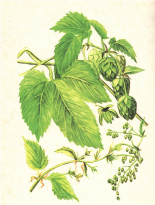Family Cannabaceae
A perennial dioecious climbing herbaceous plant that clings with hooked spines along its edges. Lower leaves are opposite, long-petioled, rounded or oval, deeply 3–5 palmately lobed with a heart-shaped base; the margins are coarsely toothed, and the upper surface is rough. Flowers are small, unisexual, with a single whorl, and yellowish-green in color. Staminate flowers form drooping panicles, while pistillate flowers with bracts are in short axillary spikes. Mature spikes form an ovoid infructescence. The fruits, small nuts, are located at the base of the enlarged bracts. It blooms in July.

It is found along riverbanks, in shrub thickets, and on the edges of light forests in Europe, the Caucasus, southern Western Siberia, the Altai, and Central Asia. It is often cultivated on industrial plantations, where unfertilized cones are preferred. These cones do not develop seeds but are otherwise identical in appearance.
The fruits, known as hop cones (Strobuli Lupuli), are harvested between August and September, just before full ripeness, during the greenish-yellow phase. Overripe cones turn yellow-brown, while unripe cones are bright green. The cones are covered in yellow glands.
In addition to cones, the separated glands, known as Lupulinum, are used. These are obtained by shaking and sieving dry infructescences, yielding a golden-yellow powder (7–16%). The cones contain essential oil (2%), a large amount of resins, bitter substances, some valerianic acid, the alkaloid inulin, choline, and other compounds. Literature suggests that cones exhibit estrogenic activity and are being studied for use in hormone therapy.
Hop cones are used as a diuretic, for gastritis treatment, and as an ingredient in calming teas. Folk remedies use hop decoctions to wash hair to strengthen it and prevent hair loss. For this, one tablespoon of cones is poured with a glass of boiling water, boiled for 30 minutes, and after cooling, massaged into the scalp.
In Hungary and Czechoslovakia, the medications «Hovaletten» and «Valosedan» are produced with dry hop cone extract and are used as sedatives.
